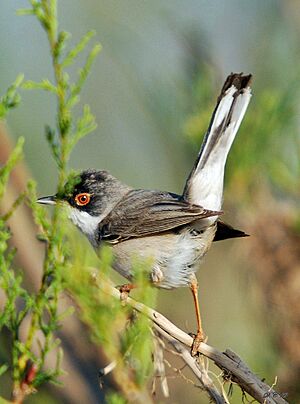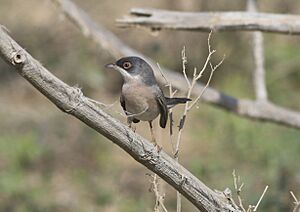Menetries's warbler facts for kids
Quick facts for kids Menetries's warbler |
|
|---|---|
 |
|
| Conservation status | |
| Scientific classification | |
| Genus: |
Curruca
|
| Species: |
mystacea
|
| Synonyms | |
|
Sylvia mystacea |
|
The Menetries's warbler (Curruca mystacea) is a small bird found in Southwest Asia. It belongs to a group of birds called passerines, which are also known as perching birds. This bird is named after Édouard Ménétries, a French scientist who first described it in 1832. It looks quite a lot like the Sardinian warbler, which lives around the Mediterranean Sea.
Contents
What Does It Look Like?
The Menetries's warbler is a small bird, about 12 to 14 centimeters (5-5.5 inches) long. Its wings can spread out to 15 to 19 centimeters (6-7.5 inches) wide, and it weighs about 9 to 11 grams. It has a fairly long, dark tail with white feathers on the outer edges. This bird often holds its tail pointing upwards and wags it up and down or side to side.
Its bill is quite strong and dark, with a pinkish part near its base. Around its eye, there is a pale, bare ring.
Male and Female Differences
- Males: The male birds of the main type (called C. m. mystacea) are dark grey on their backs and whitish underneath. They have a white stripe below their mouth and a pink throat and chest. Their head has a dark cap that is black in the front and fades to grey at the back. This is different from the Sardinian warbler, which has a completely black cap. Menetries's warblers also have plainer tertial feathers (feathers on the inner part of the wing) compared to the Sardinian warbler.
- There are two other types of Menetries's warblers:
- The western type (C. m. rubescens) is a lighter grey on top, and its pink chest might be very pale or not there at all.
- The eastern type (C. m. turcmenica) is also lighter grey on top and has paler pink underneath. It also has longer wings than the other two types.
- There are two other types of Menetries's warblers:
- Males in Winter: Outside the breeding season, male Menetries's warblers become more brownish, and their cap is not as dark.
- Females: Female birds are sandy grey-brown on their backs and buff-white underneath. They look similar to female Sardinian warblers but have plainer tertial feathers. There is also a clearer difference between their pale back and dark tail.
- Young Males: First-year males look like females but might have some pink on their throat and chest.
Sounds and Songs
This bird makes a harsh, buzzing sound. It also has a chattering call that sounds a bit like a sparrow. The male's song is a quiet chattering sound that mixes musical notes with harsh ones. They often sing while flying.
Where Do They Live?
The Menetries's warbler is a migratory bird, meaning it travels long distances between its breeding and wintering grounds.
Breeding Areas
They build their nests and raise their young in Southwest Asia.
- The C. m. mystacea type breeds near the Caspian Sea in Russia, and also in Georgia, Armenia, Azerbaijan, eastern Turkey, and northern Iran.
- The C. m. rubescens type breeds in parts of southeastern Turkey, Syria, Iraq, western Iran, and possibly Lebanon.
- The C. m. turcmenica type is found from northeastern Iran all the way east to the Syr Darya valley in Central Asia and the Balochistan region in Pakistan.
Wintering Areas
When winter comes, these birds fly west to warmer places. Their winter homes include southern Iran, the Arabian Peninsula, and Northeast Africa, from Sudan to Somalia.
A few Menetries's warblers pass through Israel and Jordan during their migration. Sometimes, a few birds get lost and are seen in places like Portugal, Nigeria, and Niger, far from their usual routes. These lost birds are called vagrants.
Their Habitat and Food
Menetries's warblers live in dry areas with a continental climate, which means hot summers and cold winters. They like places with scrubland (bushes and small trees), thickets, open woodlands, farms, and gardens. You can often find them in steppe regions (large, dry grasslands), on mountain slopes, and along rivers. They especially like areas with tamarisk bushes.
They look for food among leaves and branches. They usually start at the top of a bush and work their way down. Their diet mainly consists of insects and other small invertebrates (creatures without backbones). They also eat fruit and seeds.
Reproduction
The Menetries's warbler builds a cup-shaped nest in low plants, usually less than 90 centimeters (about 3 feet) off the ground. The nest is made from twigs, plant stems, and grass leaves. Inside, it's lined with soft materials like feathers and hair.
The female usually lays four or five eggs. These eggs are shiny white with brown spots. Both parents take turns sitting on the eggs to keep them warm, a process called incubation, which lasts for 11 to 13 days.
Once the chicks hatch, they stay in the nest for about 10 or 11 days before they are ready to fly. Both the male and female parents help to incubate the eggs and care for the young birds. These warblers usually raise two groups of young birds during each breeding season.



